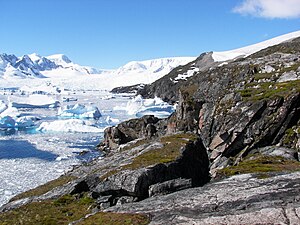Cierva Point

Cierva Point is a headland marking the southern entrance point of Cierva Cove on the Danco Coast of Graham Land, part of the British Antarctic Territory.
It is named Cierva Point in association with Cierva Cove, itself named after Juan de la Cierva, the inventor of the autogyro.
The Swedish Antarctic Expedition chartered the point as 'Kap W. Spring', in error for Spring Point, referring to part of the point incorrectly charted as an island. A spring refuge hut was built here by the Argentine Antarctic Expedition of 1953-1954, called 'Refugio Primavera' (meaning just 'spring refuge'), which was followed by a more substantial base at the 1976-77 expedition ('Base Primavera') on the point.
Conservation
The point and nearby islands, extending over 16,160 acres of land and sea, were designated a site of special scientific interest (SSSI No.15) under the Antarctic Treaty, and an Antarctic Special Protection Area (ASPA 134) for the scientific value of its unusual biodiversity. This area includes Cierva Point, Midas Island, Sterneck Island, the Moss Islands and other offshore islands as well as the intervening sea and foreshore.
There are many species of plants, birds, and invertebrates on the point and the islands: the unique topography, with the abundance and diversity of the vegetation, have created favourable conditions for the formation of numerous microhabitats.[1] The extensive coastal vegetation includes lichens, mosses and grasses, with Antarctic hairgrass (Deschampsia antarctica) and Antarctic pearlwort (Colobanthus quitensis). The mineral soils contain cyanobacteria and diatoms. Terrestrial arthropods and non-marine microalgae are abundant.[2]
The same area has been declared by Birdlife International as an 'Important Bird Area' ("The Cierva Point and offshore islands Important Bird Area"). It supports about 500 breeding pairs of south polar skuas. Other birds recorded as nesting there include imperial shags, southern giant petrels, chinstrap and gentoo penguins, Wilson's storm petrels, Cape petrels, snow petrels, kelp gulls, Antarctic terns and snowy sheathbills.[2]
At Cierva Point the south-facing slopes are glaciated, whilst the north- and west-facing slopes are ice-free. The land rises to over 1,700 feet at the coastal cliffs.
Location
- Location map: 64°9’19"S, 60°57’22"W
References
- ↑ Cierva Point and offshore islands, Danco Coast: Management Plan for Antarctic Specially Protected Area No. 134: Measure 1, Annex D: Antarctic Treaty Secretariat (2006)
- ↑ 2.0 2.1 Cierva Point and offshore islands IBA: BirdLife International
- Gazetteer and Map of The British Antarctic Territory: Cierva Point